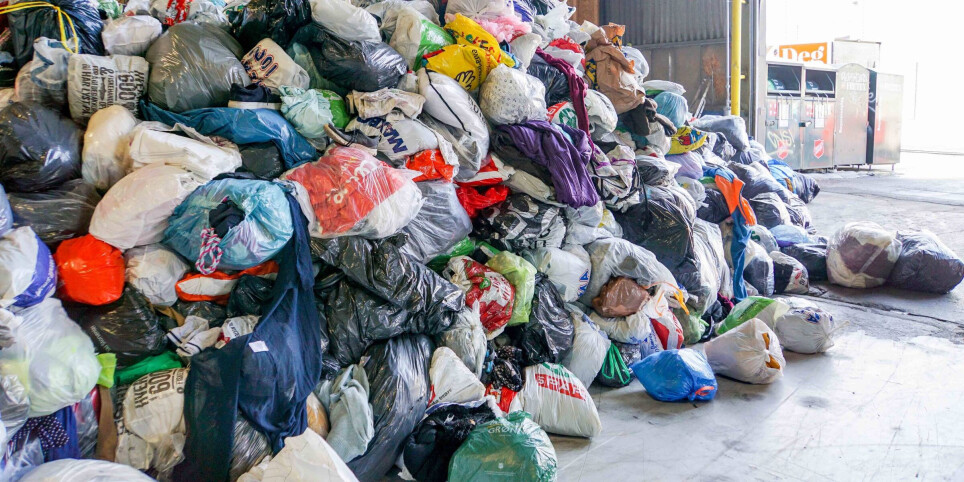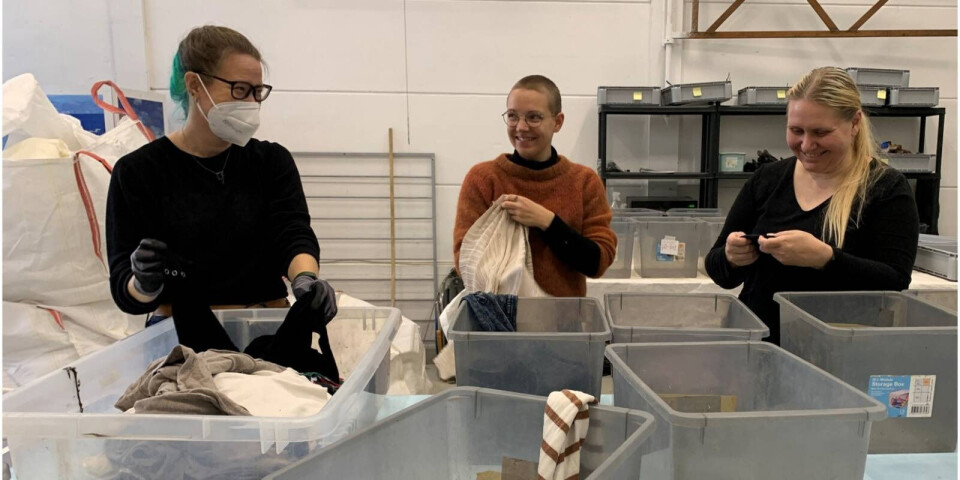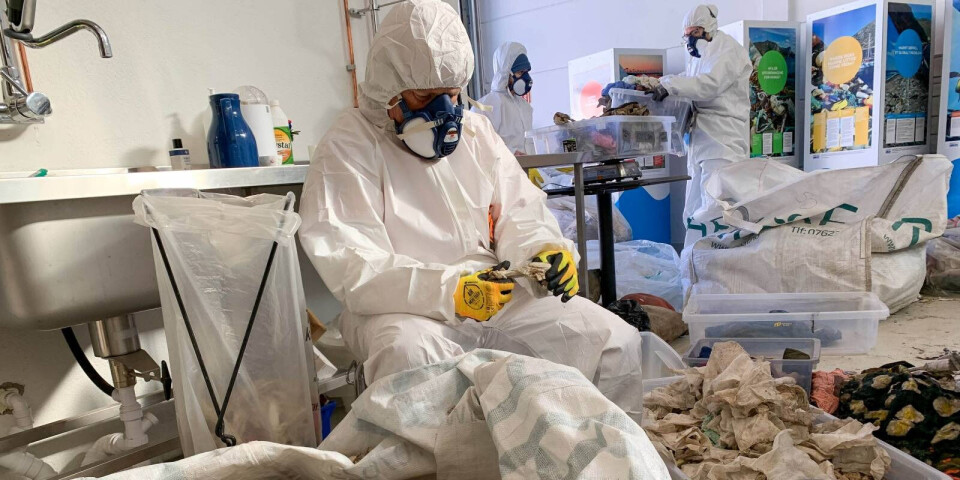THIS ARTICLE/PRESS RELEASE IS PAID FOR AND PRESENTED BY Oslo Metropolitan University - read more

Enormous amounts of clothing never get worn. Most of it ends up as waste
Much of it contains plastic and other synthetic fibres.
After cleaning out your wardrobe, you might be left with a pair of trousers with a hole in them, a sweater you stopped wearing a long time ago or a dress you ended up never wearing.
Where should you dispose of the clothes you want to get rid of?
In Norway, you can put clean and functional garments in a clothing collection container, but what about damaged or poor-quality clothes?
“There are few other options than throwing them in the trash,” PhD candidate at OsloMet Anna Schytte Sigaard says.
However, this will not be an option for much longer. Textiles are prioritised in the EU’s Circular Economy Action Plan. By 2025, separate textile collection will be mandatory, also in Norway.
How to organise large-scale textile collection?
“To find out how to organise the mandatory textile collection, we need to know what types of textiles are thrown in the trash or end up in other waste or recycle streams," Sigaard says.
She is part of Consumption Research Norway’s Clothing Research team where she is involved in the research project Wasted Textiles.
The project studies the fate of all the textiles that go out of use. Why do we throw away clothes, what do we throw away, and what do we choose to keep?
What is the condition of the clothing that is thrown away, and how much is made of synthetic materials, i.e., plastic?
What can we do with the textiles that are collected? Can they be recycled in some way, so that the materials can be reused?
“In that case, we first need to find out what the clothes are made of. Material recycling is difficult, and with mixed materials it is almost impossible. The next product is almost always of poorer quality,” Sigaard explains.

Deep dive into our waste
To find answers, the researchers have gone through our textile waste from different waste sources.
They have been through textiles from our regular waste, from clothing collection containers and from recycling facilities where people can deliver clothes as waste.
“We had to start by developing the picking analysis method,” says Sigaard.
Mepex, a consulting company for waste and recycling, helped the researchers in this process.
Dressed in protective suits and masks, they went through a total of 3,500 kilos of textile waste, some of it soiled, smelly and ruined, while other things were as good as new.
They looked at different types of textiles, the fibre content, and the condition of the garments.
“We found a surprising number of garments with the price tag still attached, also at the waste recovery stations. People have thrown away completely new garments,” she says. “Everything from the residual waste, however, was ruined, as the textiles were mixed with food waste and everything else, and impossible to assess. Clothes from the trash have no use value."

Surprised by the amount of plastics
Two thirds of the textiles examined contained some or mainly synthetic fibres, i.e., non-renewable materials or plastics. Polyester is the largest category, but acrylic, elastane and nylon were also prevalent.
The rest, a third of the textiles, were natural materials or what we call renewable materials, such as cotton, wool and silk. Or viscose, which is also plant-based and degradable, but has undergone intensive chemical processing.
“We were surprised by the large proportion of plastic, as we included all textiles, and found a lot of bed linen and towels, which are most often made of cotton. Still, there is an inordinate amount of synthetic altogether,” continues Sigaard.
There is also reason to believe that the proportion of plastic clothing in the trash will increase in a few years.
"If we had only included clothing, there would have been an even greater proportion of plastic. Over two thirds of all materials in textiles produced today are synthetic," she says.
There is a constant growth in the production of synthetic textiles, and the clothing bought today will be thrown away in a few years. The clothes we find in the trash today have of course been bought back in time.
Analysing over 3,000 discarded clothing items
All clothing has a label showing the fibre content. This is required by law. But how precise is this label?
Investigations in other countries show that many clothes are mislabelled and contain a greater proportion of synthetic materials than what is stated on the labels. Does this also apply in Norway?
To test this, the Wasted Textile researchers have borrowed a FabriTell fibre scanner – a small, hand-held machine that uses near-infrared analysis technology to identify the fibre composition in textiles.
The researchers scanned a selection of 3,000 discarded clothing items that had been collected from 28 households, as a part of Sigaard’s PhD work. They chose everything that was labelled as mixed fibres or not marked at all.
“We found a lot that was mislabelled. For example, t-shirts or hoodies may be labelled as 100 per cent cotton, while the scanner shows that the ribbed edges are mixed with synthetic materials. This is within the law, but gives incorrect information,” Sigaard points out.
We need to reduce production
All knowledge that emerges in the Wasted Textiles project can be used in the work to fulfil both policy issues and other incumbent textile requirements the new Circular Economy Action Plan the EU will spearhead.
Denmark will start a separate textile collection system as early as June 2023, and hopefully Norway will follow in 2025.
Overproduction of clothing is made possible due to the large amount of polyester and other cheap plastic materials used by the apparel industry.
This creates enormous amounts of textile waste that leach microplastics and chemicals. The waste often ends up as waste mountains in the Global South, as we have seen in the media from Chile and Ghana.
“The most important thing is to reduce the amount of waste. For this to happen, all actors in the value-chain must agree, or be forced to do so. As of now, the industry is only concerned with recycling opportunity, not reducing production,” Sigaard concludes.

This article/press release is paid for and presented by OsloMet
This content is created by Oslo Metropolitan University's communication staff, who use this platform to communicate science and share results from research with the public. Oslo Metropolitan University is one of more than 80 owners of ScienceNorway.no. Read more here.
See more content from OsloMet:
-
Researcher: Local government was key to managing the pandemic
-
"Norwegians practice a friendship version of a ‘one-night stand'"
-
"We need to talk about how we assess teacher students"
-
Cannabis use in Norway has increased: “Not everyone needs moral lectures or worried looks"
-
Many children with ADHD do not thrive at school
-
An out-of-control race: Why we fear artificial intelligence




































